Proactive Healthcare Security using the IoE Approach

September 6, 2024
In the rapidly evolving landscape of modern healthcare, compliance, risk, and resilience management have become critical priorities. Healthcare organizations are entrusted with sensitive and personal data. If compromised, this data could have adverse consequences, impacting patient trust, clinical operations, and the overall stability of healthcare services. As technology continues to transform healthcare through the integration of electronic health records (EHRs), telemedicine, and IoT devices, the industry's attack surface expands. This advancement, while improving patient care, also introduces new vulnerabilities. Cybercriminals increasingly target healthcare institutions, recognizing the value and sensitivity of the data they hold. The consequences of these attacks can include operational disruptions, financial losses, and, most critically, potential risks to patient safety. Recent incidents underscore the urgency of robust cybersecurity measures that extend beyond traditional defenses. In an environment where a single breach can compromise the health information of thousands, healthcare organizations must adopt a proactive and comprehensive approach to security.
What Are Indicators of Exposure (IoEs)?
Indicators of Exposure (IoEs) offer a proactive strategy for identifying and managing risks before they evolve into serious security incidents. IoEs are key metrics or signals that help organizations detect vulnerabilities and weaknesses in their systems—issues that cyber attackers could exploit if ignored. IoEs focus on early risk detection and prevention, allowing organizations to address threats before they escalate.
Why Are IoEs Important? IoEs shift the focus from reacting to security breaches to preventing them altogether. In healthcare, they monitor vulnerabilities like IoT misconfigurations, weak access controls, and compliance gaps, helping organizations stay ahead of threats. This proactive approach safeguards patient data, ensures regulatory compliance, and strengthens operational resilience.
In a sector where the stakes are exceptionally high, the adoption of IoEs is more than just a strategic advantage; it is a necessary evolution in how healthcare organizations protect their most critical assets.
Security Challenges in Healthcare - A Closer Look
The healthcare industry is at the forefront of integrating cutting-edge technologies like IoT devices, electronic health records (EHRs), telemedicine, and medical equipment. However, this technological advancement also introduces significant security challenges, making healthcare one of the most vulnerable sectors to cyberattacks.
Complexity of Healthcare Systems Healthcare systems today are an intricate web of interconnected technologies designed to enhance patient care and streamline operations. However, this interconnectedness also increases the complexity and the attack surface. For instance, IoT devices—ranging from patient monitoring systems to smart medical equipment—are now ubiquitous in healthcare environments. While these devices improve patient outcomes, they often lack robust security features, making them prime targets for cyber threats. Misconfigurations in these IoT devices, especially at the sensor level within hospital networks, can create vulnerabilities that attackers can exploit to gain unauthorized access to critical systems.



